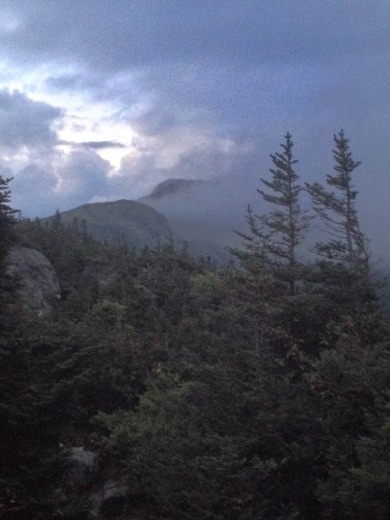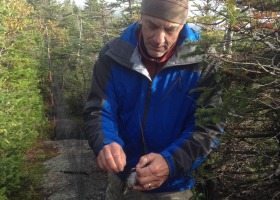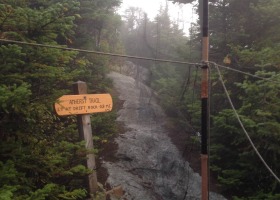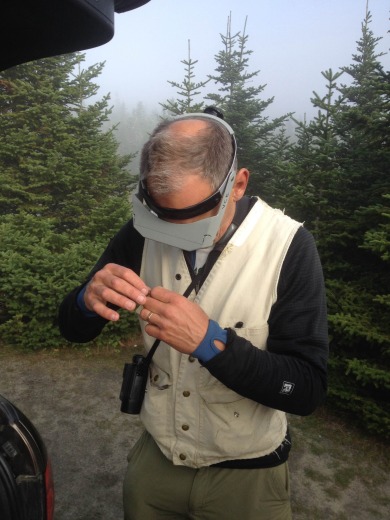VCE wrapped up its 2014 mountain bird field season with an overnight visit to our Mt. Mansfield ridgeline study site on Tuesday. Arriving at the upper toll road parking lot ~5 pm, we were greeted by chilly, damp conditions, but also by calling Bicknell’s Thrushes (BITH), which annually undergo a resurgence of vocal activity in mid-September. We set up 17 mist nets, mostly on the Amherst and Lakeview trails, and ran them until dusk. BITH calls pierced the skies until darkness fell, and a few birds sang briefly. The frequency and vigor of vocalizing was nowhere near that of 3 months ago, but the chorus was a far cry from the eerily quiet evening of our visit in late July.
The ridgeline was still bathed in clouds when we returned at 5:45 am to open nets, and temperatures hovered in the raw low 40s F. BITH put on a solid dawn chorus, as we heard 16-18 birds total. Swainson’s Thrushes were nowhere to be seen or heard. Our nets started filling, and by noon we had captured 76 birds. Yellow-rumped Warblers were by far the most abundant species on the ridgeline, and in our nets, but BITH may have been second, judging from both captures and birds heard vocalizing. Of the 13 BITH we mist-netted, 5 were recaptures of adult males from June and July (one a bird originally banded in 2011). Our total of BITH captures for 2014 ended up at 57, possibly a single-season record over our 23 years of banding.
Overall diversity on the ridgeline was low, as we identified only 16 species during the morning, which included 2 Sharp-shinned Hawks and a single Peregrine Falcon. One unexpected encounter was of 3 Ruffed Grouse flushed at ~3800 ft elevation on Tuesdayevening. Surprisingly, Black-throated Blue Warblers, which our fall migration banding study in the mid-1990s showed to be the most abundant transient species on Mansfield, were almost non-existent – we saw and netted only one bird. [read more about our results from that study, http://www.vtecostudies.org/PDF/WB112.pdf].
Our combined capture totals for the 16-17th:
Black-capped Chickadee 1
Bicknell’s Thrush 13 (7 immatures, 1 new adult, 5 recaptured adult males)
Nashville Warbler 1
Blackpoll Warbler 6 (2 immatures, 4 adults)
Black-throated Blue Warbler 1 imm. female
Yellow-rumped Warbler 50 (41 immatures, 9 adults)
White-throated Sparrow 6 (3 immatures, 3 adults)
Dark-eyed Junco 8 (7 immatures, 1 adult)
A final note: there are very few cones on the balsam fir trees (and we saw or heard no red squirrels), so it’s likely that squirrel populations will again be low in 2015, leading to higher breeding productivity by BITH and other open-cup nesting species. The biennial “boom-bust” cycle of cone crops, which has been remarkably consistent across the entire Northeast for many decades, appears to have broken down in recent years. Whether this results from climatic changes and/or other environmental factors, and whether the cycle will self-correct or not, is unknown. In the short term, the current scarcity of cones in montane forests appears to be benefitting BITH, which have shown relatively high recruitment of young birds during the past 3 summers, and probably will again in 2015.
VCE will be back at it again next June, so stay tuned.




